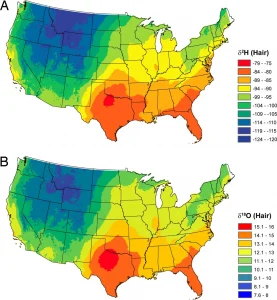Can you spare 2 mL of tap water?
Citizen Science + Isotopes + SPATIAL family = a project I want to help out with.

The isotopes of water vary systematically across landscapes due to evaporation and precipitation processes. Given this, we can pretty easily distinguish water between Miami and Omaha (or Colorado Springs and Aspen). Given that our bodies reflect what we consume, by looking at the isotopes in human remains we can identify where they are from (interesting case described here). However, because cities pipe water from faraway places, this mucks up the predictable pattern (i.e. in Colorado Springs our water is going to make our bodies look like we are living in Breckenridge, while in Manitou, water is sourced locally so folks over there should look more “local”).
Here’s where Gabe Bowen’s project comes in – Historical Isoscapes for Servicemember Identification. Gabe is doing a big citizen science push to collect tap water to sort out the messy parts of the map (i.e. cities) so that they can make a better isoscape (map of isotope values, see figure) to help identify servicemember remains (i.e. your tap water samples could help with forensic work!).
All I need is 2 mL of water (I will give you the tiniest of vials) and a bit of data (e.g. date and time of sample, lat long coordinates of your house). If you are interested get in touch via email so I can get you a vial or two!
Already have your water? Please remember to fill out the short form online so we have all the necessary info and drop off your vial(s) in my mailbox on campus (Tutt Science 130) or at the Pure Barre studio across from UCCS (on North Nevada).
Still have questions? See a set of FAQs provided by Gabe below…
Tap water sampling for isotope analysis: FAQs
What is this all about? With your help and/or that of your friends or students, we are crowd-sourcing samples to develop a large, national dataset of stable isotope ratios of tap water. Several data sets of this type already exist, but here we’re emphasizing sampling extensively within cities, which has only been done in a small number of cities previously.
What are we measuring? We are measuring stable isotope ratios of hydrogen and oxygen in water (2H/1H and 18O/16O) and, in a subset of samples, strontium isotope ratios (87Sr/86Sr).
What can these data tell us? Water stable isotope ratios are useful for inferring the sources that contribute to drinking water. They can reveal unexpected and undocumented heterogeneities in water supplies, demonstrate links between water management and climate, and are potentially useful as a tool for water managers. From a pedagogical standpoint, these measurements are a nice way of exploring links between human-managed and natural water resources, prompting students to think about safety and sustainability of their local water supplies, and illustrating fundamental concepts of isotope geochemistry and hydrology.
Why is the SPATIAL group interested? In addition to the water resources applications described above, we are interested in forensic applications of water isotope data (isotopically, “you are what you drink”). In this specific case, our group is working with a US Department of Defense agency to develop drinking-water stable isotope maps that can be used to constrain the home locations and identity of remains of American soldiers lost in foreign wars (project info). The city-scale data will help us develop models for the use of multiple (e.g., surface and groundwater) resources in urban areas. For groups that are able to provide samples of well water, those data will become part of a nation-scale dataset used to build groundwater isotope maps.
What will happen with the data? All water isotope data collected by our group are publically available via the Waterisotopes Database (wiDB: http://waterisotopesDB.org). New data from this project will be posted there as soon as the samples have been analyzed and quality controlled.

Comments are closed